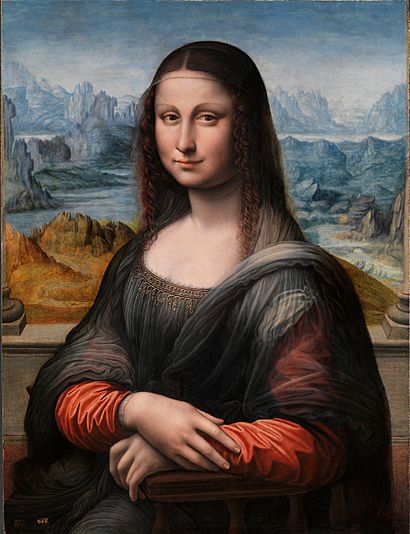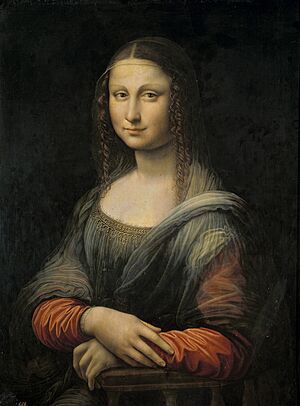Mona Lisa (Prado) facts for kids
Quick facts for kids Prado Mona Lisa |
|
|---|---|
 |
|
| Artist | Workshop of Leonardo da Vinci |
| Year | c. 1503–1516 |
| Medium | Oil on walnut panel |
| Subject | Lisa Gherardini |
| Dimensions | 76.3 cm × 57 cm (30.0 in × 22 in) |
| Location | Museo del Prado, Madrid |
The Prado Mona Lisa is a famous painting made by artists who worked with Leonardo da Vinci. It looks just like Leonardo's own Mona Lisa, which is in the Louvre museum in Paris. The Prado Mona Lisa has been at the Museo del Prado in Madrid, Spain since 1819. For many years, people thought it was just an unimportant copy.
But after it was cleaned and fixed in 2012, experts realized something amazing. This painting is now known as the earliest copy of Leonardo's masterpiece. It was likely painted by one of his students in the very same art studio where Leonardo painted his original Mona Lisa. This makes it a very special and historically important copy. Some experts think Salaì or Francesco Melzi, who were students of Leonardo, might have painted it.
History of the Painting
The story of the Prado Mona Lisa is closely connected to Leonardo's original painting. Both were probably created at the same time in Leonardo's workshop. The first time this painting was written about was in 1666. It was listed in a collection in Madrid as "Woman by Leonardo da Vinci's hand."
We don't know exactly when the painting arrived in Spain. But it might have been there as early as the 1600s. Since the Prado museum opened in 1819, this copy has always been part of its art collection.
Amazing Restoration Work
Before its restoration, the painting was thought to be just an old copy by an unknown artist. Even so, it often hung next to famous paintings by other Italian artists like Raphael. There was even a printed picture made of it, which was unusual for a painting thought to be just a simple copy.
One big difference between the Prado version and the Louvre's Mona Lisa was that the Prado painting had no landscape background. This background was completely uncovered during the restoration work done by the Prado museum between 2011 and 2012. This work was done so the painting could be shown in a special exhibit at the Louvre.
During the restoration, they found that a black layer of paint had been added about 200 years after the painting was made. This means the black paint was added around 1750. Scientists also used special tools like infrared and X-rays to study the painting. These tests showed that the painting was indeed made in Leonardo da Vinci's workshop. Even more exciting, it was painted at the same time as the original Mona Lisa! The hidden drawings underneath the paint were very similar, but with small differences in style.
These discoveries are very important. The Prado painting is in excellent condition, much better than the original. It shows us what the Mona Lisa looked like when it was first painted. The original Mona Lisa has old, yellowed varnish that makes its colors look different. The Prado copy helps us imagine the bright, fresh colors Leonardo used. This also helps experts learn more about Leonardo's original masterpiece.
Some people even thought that if you looked at the Prado version with one eye and the Louvre version with the other, it might create a 3D effect. This idea came from the fact that Leonardo wrote about how our eyes see things in 3D. However, later studies showed that this 3D effect doesn't really happen with these two paintings.
See also
 In Spanish: La Gioconda (taller de Leonardo da Vinci) para niños
In Spanish: La Gioconda (taller de Leonardo da Vinci) para niños


